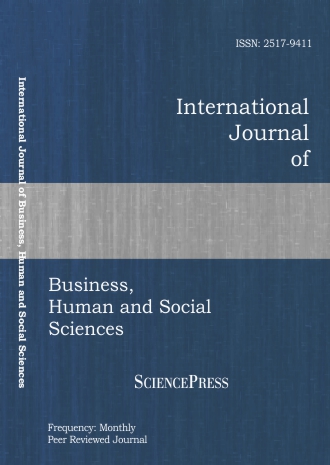
Scholarly
Volume:9, Issue: 5, 2015 Page No: 1483 - 1488
International Journal of Business, Human and Social Sciences
ISSN: 2517-9411
Client Satisfaction: Does Private or Public Health Sector Make a Difference? Results from Secondary Data Analysis in Sindh, Pakistan
Introduction: Researchers globally have strived to explore diverse factors that augment the continuation and uptake of family planning methods. Clients’ satisfaction is one of the core determinants facilitating continuation of family planning methods. There is a major debate yet scanty evidence to contrast public and private sectors with respect to client satisfaction. The objective of this study is to compare quality-of-care provided by public and private sectors of Pakistan through a client satisfaction lens. Methods: We used Pakistan Demographic Heath Survey 2012-13 dataset on 3133 women. Ten different multivariate models were made. to explore the relationship between client satisfaction and dependent outcome after adjusting for all known confounding factors and results are presented as OR and AOR (95% CI). Results: Multivariate analyses showed that clients were less satisfied in contraceptive provision from private sector as compared to public sector (AOR 0.92, 95% CI 0.63-1.68) even though the result was not statistically significant. Clients were more satisfied from private sector as compared to the public sector with respect to other determinants of quality-of-care follow-up care (AOR 3.29, 95% CI 1.95-5.55), infection prevention (AOR 2.41, 95% CI 1.60-3.62), counseling services (AOR 2.01, 95% CI 1.27-3.18, timely treatment (AOR 3.37, 95% CI 2.20-5.15), attitude of staff (AOR 2.23, 95% CI 1.50-3.33), punctuality of staff (AOR 2.28, 95% CI 1.92-4.13), timely referring (AOR 2.34, 95% CI 1.63-3.35), staff cooperation (AOR 1.75, 95% CI 1.22-2.51) and complications handling (AOR 2.27, 95% CI 1.56-3.29). Discussion: Public sector has successfully attained substantial satisfaction levels with respect to provision of contraceptives, but it contrasts previous literature from a multi country studies. Our study though in is concordance with a study from Tanzania where public sector was more likely to offer family planning services to clients as compared to private facilities. Conclusion: In majority of the developing countries, public sector is more involved in FP service provision; however, in Pakistan clients’ satisfaction in private sector is more, which opens doors for public-private partnerships and collaboration in the near future.